Power IRV, or: How I Learned to Stop Worrying and Love Ranked Choice Voting (part 2)
This is the third post in a series on voting reform:
- Power IRV (intro) - How to Escape the Two-Party Political Doom Loop
- Power IRV (part 1) - Power IRV, or: How I Learned to Stop Worrying and Love Ranked Choice Voting
- Power IRV (part 2) - Why Power IRV beats out all other voting systems (you are here)
- Power IRV (appendix) - Appendix: FAQs and Followups / Full Walkthrough
If you’re not sure what our current FPTP voting system is or why it needs to go, get your learn on with Power IRV (intro).
If you didn’t get the rundown on what Power IRV is and how it works, get a quick overview in Power IRV (part 1).
Otherwise, read on!
Why Power IRV beats out all other voting systems
So election nerds like to argue about whose voting method is the biggest… alignment with voters’ actual desires, which is most resistant to strategic voting and all sorts of other crazy criteria.
Here’s a sample chart showing how complicated it all gets:
(You definitely don’t need to to worry about understanding this chart right now)
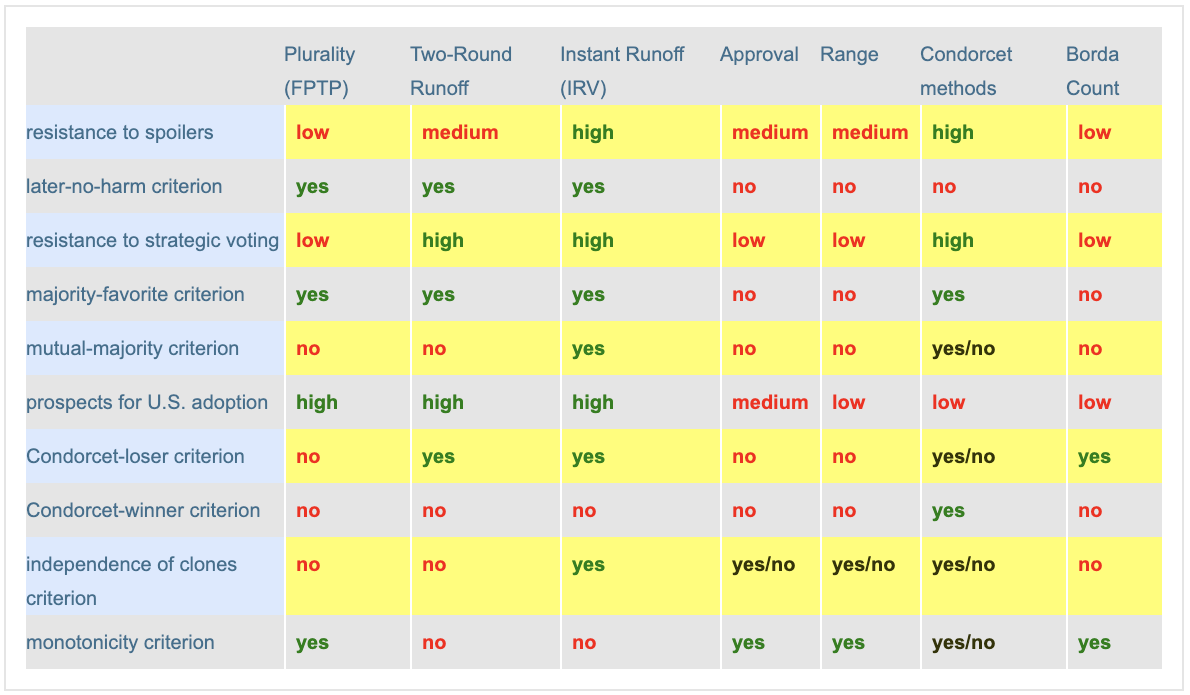
Way more detail than needed for normal humans
[chart and references are at FairVote, who are very hot for IRV as you can see]
This chart is a little misleading as it downplays the super annoying problem with IRV that we saw in Power IRV (part 1):
IRV does not allow voters to always vote for their favorite no matter what, especially in the circumstances where it matters the most: when your honest favorite is just about to become a frontrunner.
As a reminder, this problem was the result of the “Center Squeeze” effect - where IRV throws out a broadly appealing centrist when choosing the final 2 candidates just as the advancing 3rd-party candidate becomes more popular than the centrist but not yet strong enough to defeat the other major-party opponent.
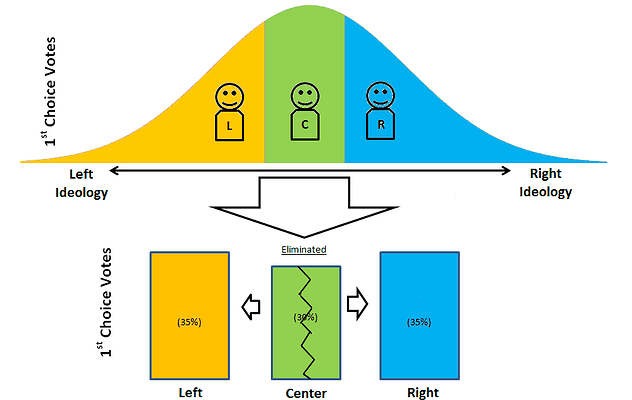
IRV was so promising…
Ugh. OK, so what other choices do we have?
Let’s look at the next most popular voting alternative: Approval Voting. Here, instead of voting only for your favorite, you can vote for as many candidates as you like who you would approve to hold office:
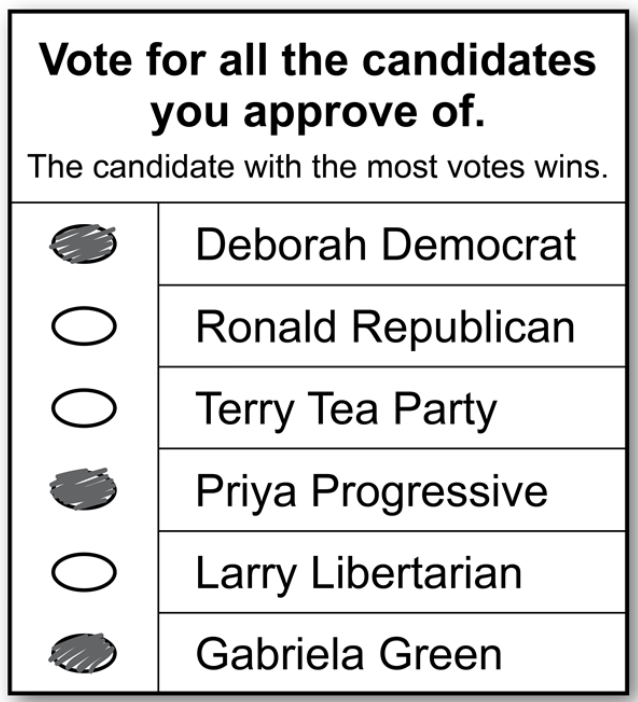
What is Approval Voting? All voters vote for all candidates
they find acceptable. Count up all the votes - highest total wins.
While Approval Voting has many good qualities, it has two fatal flaws:
- You can’t express your preference between approved candidates - you give the same vote to:
- the one you love
- the one you like, and
- the one you can barely stand to prevent an even worse opponent from winning
- Approval Voting often devolves into strategic bullet voting in practice
- Bullet voting is where you vote highest for your favorite, and lowest for everyone else.
- Why bullet vote?
- voting for any non-favorite gives that other candidate a better chance of winning
- voters are rewarded to strategically withhold votes from other strong contenders

Good luck convincing 2016 Bernie Bros to give the same vote to him and to Hillary.
For years, voting reform has been stuck between these two main factions:
- Let’s use IRV! YOLO!!
- I like to feel good by voting my preferences and getting to support my favorite the most
- I don’t know about IRV’s center squeeze problem
- I just want to do anything to get us unstuck here and IRV has that mainstream mojo
vs.
- Approval voting is the move
- I am a voting nerd and know about IRV and favorite betrayal
- I don’t mind giving the same score to the candidate I love, the one I like, and the one I hold my nose for
- I enjoy fighting an endless battle against people who can’t possibly stomach voting the same for Hillary and Bernie
People get all excited about IRV, then they end up talking to the voting math people somewhere along the way, and they all push back on how IRV is terrible and if we’re going to go through all the trouble to change, let’s change to something that actually improves things significantly and all the initial excitement drains away like someone told them they’re about to be stuck on an 8-hour car ride with a group of Crossfit vegan anti-vaxxers.
And then suddenly all the other voting method proponents swoop in and now you have a 6-way discussion that winds up with everybody giving up and just getting drunk instead. And here we are.
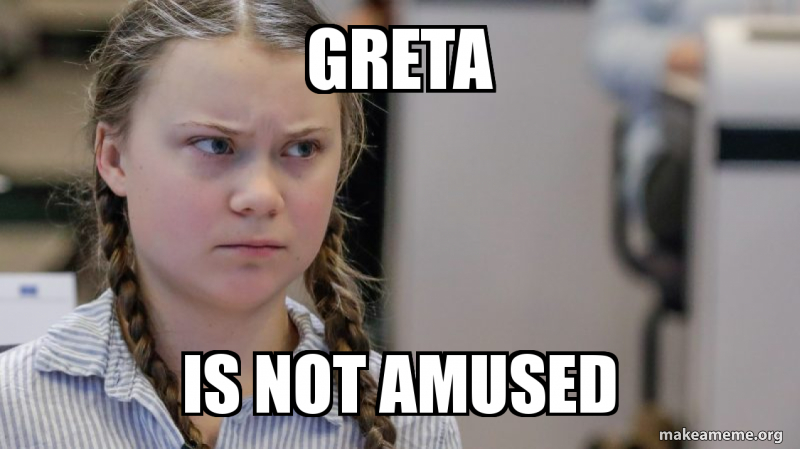
Approval Voting proponents do have some good points, namely that Monotonicity is important and how Approval Voting never suffers from Favorite Betrayal - and so they argue we should just shut up and get down with the APP.
There is a better way
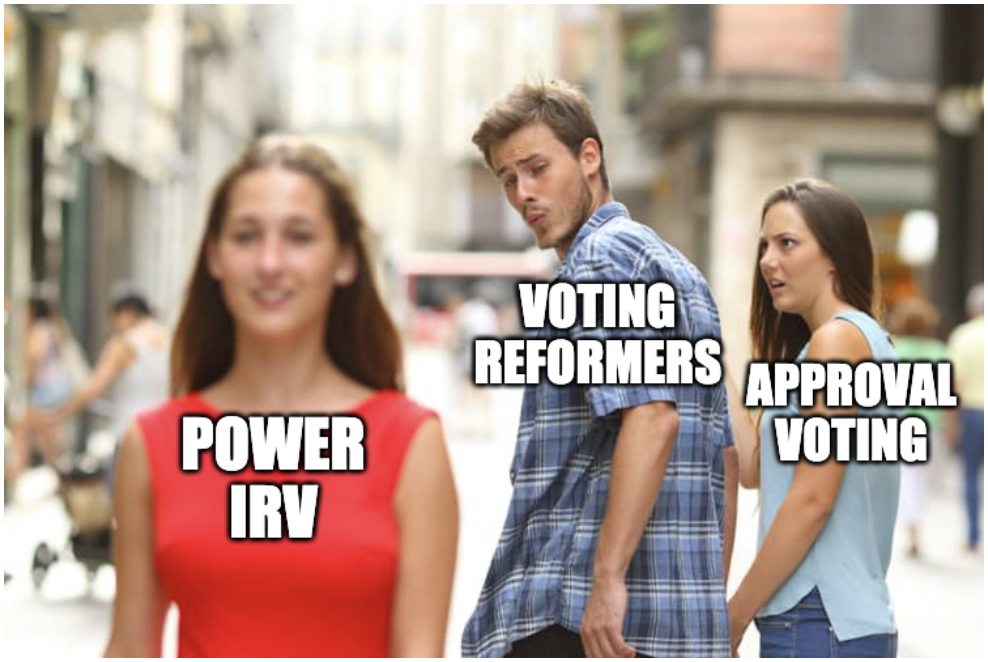
Sorry, Approval Voting: Power IRV is the New Hotness
Let’s review: Power IRV works exactly like regular IRV until you get down to the last 3 finalists.
At this point we have to do something to fix the center squeeze issue, which was the killer for regular IRV. How do we deal with that?
Power to the rescue
So we probably could have called this “IRV + Pairwise Finalists”, or “IRV with a Condorcet Nightcap” or something, but what fun is that? POWER.
(I didn’t think calling it Condorcension was going to go very far either)
OK anyways - whatever we call it, the trick is to just pick the winner from the 3 finalists by finding what is called the Condorcet winner (oh, that’s where those names came from):
- first, run elections between each pair of candidates
- if anyone beats both both other candidates head-to-head: congrats! You win!
But I thought the Condorcet method doesn’t always work?
Wait, what are you, some kind of electo-nerd? OK, ok, ok, yeah you’re right - that’s totally true. Much like the rhythm method, the Condorcet method doesn’t always work.
What?!?! How’s that?
Yes, Virginia: sometimes there is no Condorcet winner.
It turns out to be pretty easy to understand, actually. Imagine 3 candidates, and now say that voters prefer A over B, B over C and C over A (so it’s a loop!). Bummer.
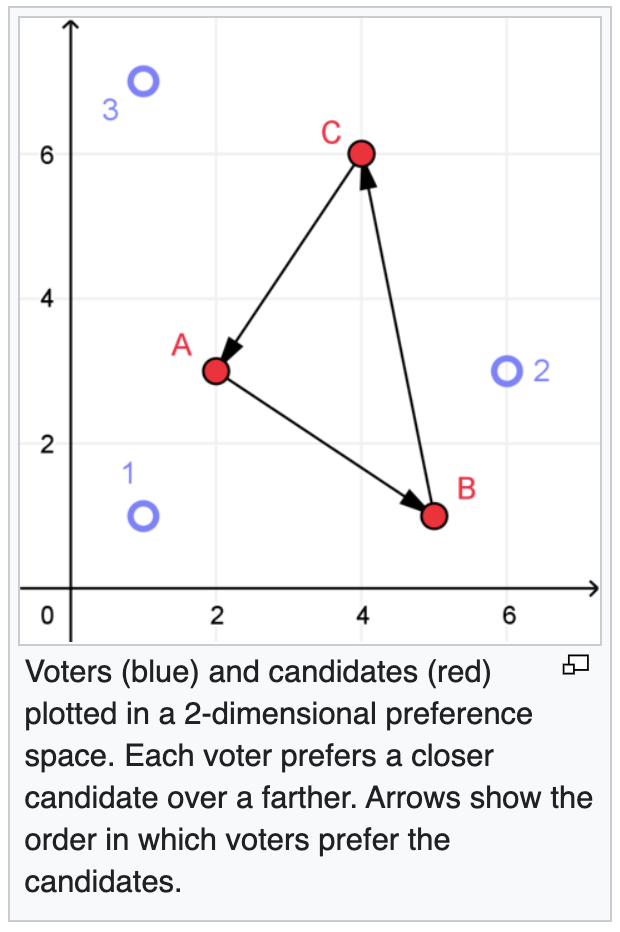
But wait - it’s OK! We can fix this too (and in a pretty logical way). We just throw in a little twist - if we have no clear head-to-head winner, let’s:
- tally up the votes in each race* (so 3 sets of head-to-head totals)
- whoever has the highest vote count in any race wins**
The idea is that by running the 3 pairwise elections and taking the highest total count, we will pick the best coalition-builder. If one of the candidates were to drop out, which of the others can build the strongest coalition including these orphaned supporters?
This is the trick to fixing the center squeeze problem - if either of the final 3 regular IRV losers can combine forces to defeat a center-squeezed winner, they should win - and by taking the highest vote total overall, you can see which coalition has the greatest overall support.
* In case a voter only ranked 1 of the last 3 finalists, we just split their vote and count it 1/2 for both of the others when their only choice is removed (since they gave us no preference)
** We do have to worry about a super-rare 2-way tie, but guess what? We just found the pairwise winner for that scenario too 😉
(You can get even deeper into the specifics in the Appendix)
Let’s Get Down To It
OK, so we’ve done a lot of talking, but can you get your hands dirty and try out this business?
YES.
Thanks to a wonderful post by Nicky Case, we can go through an interactive exploration of different voting systems to compare how they work. I’ve added a handful of his scenarios here, and also added in the Power IRV approach as a new option. Check it out:
Show me the squeeze
Here’s the main case where basic Instant Runoff Voting runs into trouble. In the beginning, Tracy Triangle  is already winning, and you’re going to move the voters even closer to her. Obviously, if a candidate is already winning an election, and becomes even more popular, they should still win afterwards, right?
is already winning, and you’re going to move the voters even closer to her. Obviously, if a candidate is already winning an election, and becomes even more popular, they should still win afterwards, right?
drag the voters  slowly up towards
slowly up towards  :
:
Cool, huh?
(Well, OK - except that the problems with IRV are decidedly not so cool.)
Anyways, now let’s go back and see what happens with Power IRV - try dragging the voters  up again after you click on the
up again after you click on the PowerIRV button. Go ahead. We’ll wait.
(You can also push reset if you moved too many things around)
Did you see how Power IRV’s minor tweak with the final 3 candidates made all the difference and solved the problems we saw with normal IRV?

Nice.
OK, so what other scenarios come up that go all pear-shaped under other voting methods but work out fine under Power IRV?
Score Voting
After Approval Voting, the next-most popular method is Score Voting (aka Range Voting):
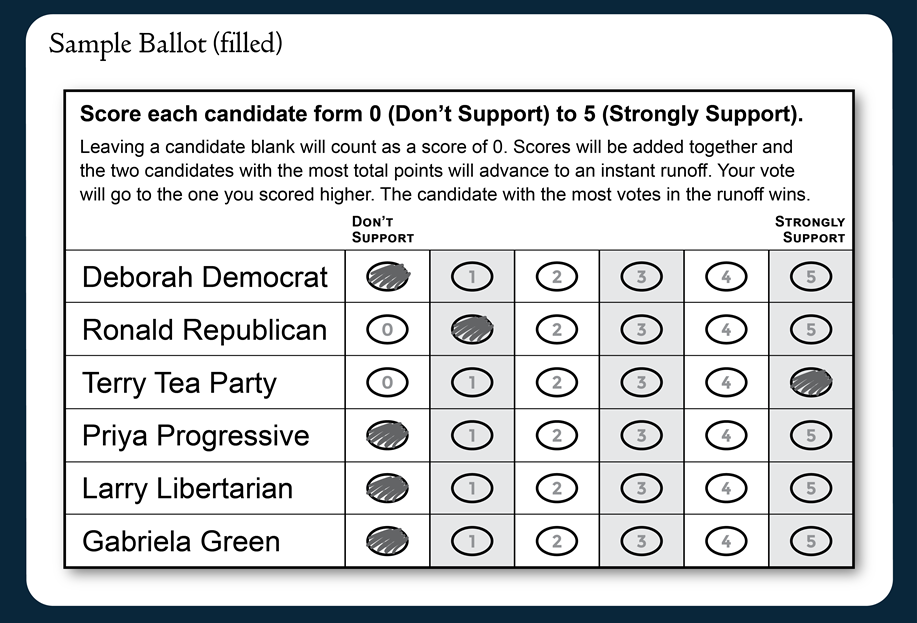
- Voters rate all candidates on a scale (usually 0-5, just like on Amazon or Yelp)
- All ratings are added up
- The candidate with the highest rating total wins
Like Approval Voting, Score Voting has a number of good qualities, but it too suffers from fatal flaws:
-
It fails the Majority Criterion: if one candidate is preferred by a majority (more than 50%) of voters, then that candidate must win
-
It also fails:
- Later No Harm: a voter giving a higher rating to a less-preferred candidate can not cause a more-preferred candidate to lose, and
- Participation: abstaining from an election should never help a voter’s preferred choice win
…but let’s look for the intuitive place where Score Voting fails* - check out this scenario:
* besides the whole “try and figure out how to rank everybody on a scale with too many choices” thing… Did I get it right? What if I scored these guys too close? Or not close enough? Now try that with 5 or 10 different candidates - good luck
In this case 2/3 of voters dislike both candidates, but definitely dislike Square  : much less. However, 1/3 of voters LOVE Triangle
: much less. However, 1/3 of voters LOVE Triangle  and HATE Square
and HATE Square  :.
:.
Here, Score gives it to Triangle  , while every other voting method says Square
, while every other voting method says Square  : should win. Is Triangle
: should win. Is Triangle  the right answer? It’s very hard to argue that Triangle
the right answer? It’s very hard to argue that Triangle  winning is a better outcome here - this is very clearly not “majority rule”. In fact, exactly the opposite - and thus why Score voting fails the Majority Criterion.
winning is a better outcome here - this is very clearly not “majority rule”. In fact, exactly the opposite - and thus why Score voting fails the Majority Criterion.
should fanatics override a less-loved but more representative candidate?
The Borda Reverse Spoiler
Another Score Voting variant is called the Borda Count. You simply take a ranked ballot (from 1 to whatever) and add up the rank numbers for all ballots. Like in golf, whoever has the lowest score, wins.
In this next simulation, you move a losing candidate closer to another losing candidate. Under FPTP, the spoiler effect would split their votes, making both of them lose even more. But watch what happens under Borda Count instead…
drag  to just slightly left of
to just slightly left of  :
:
Did you see where Borda Count had a reverse spoiler effect? Instead of one good candidate hurting another good candidate by moving closer, with Borda Count, one bad candidate can help another bad candidate by moving closer.
Did you try with Power IRV? If not, go for it.
(Spoiler alert: Power IRV DGAF about your crappy hexagon candidate’s antics.)

Now let’s do a little rewind and look at some revisionist history with the 2016 election. Let’s imagine that instead of FPTP we had rocked it out with Power IRV.
By using Power IRV, we totally remove the spoiler effect - and this means that Bernie could have also run in the general election without risking Hillary’s chances.
Bring Bernie Back
Let’s see what would have happened if Bernie could have run as a 3rd candidate:
a guesstimated model of the 2016 US election?
how
- Trump
 wins FPTP (spoiler effect), IRV (center squeeze), and Approval (Sanders gets torpedoed by the
wins FPTP (spoiler effect), IRV (center squeeze), and Approval (Sanders gets torpedoed by the  Democratic party)
Democratic party) - Clinton
 wins Score, and
wins Score, and - Sanders
 wins Borda, Condorcet, and Power IRV:
wins Borda, Condorcet, and Power IRV:
What about all these other voting systems?
OK then, let’s go a little deeper here - time for some research.
It turns out that in the worst case, regular IRV is about the same as FPTP(!) for reaching voter satisfaction, and it can be a little better. But Approval voting is much better.
Here’s a crazy chart (source) showing the results of 2.2 million simulations. A huge variety of scenarios were tested. All-honest voters. All-strategic voters. Half-honest, half-strategic. Voters who know each others’ preferences. Voters who don’t know each others’ preferences. Voters who only sorta-know each others’ preferences. And so on.
You can tell that a real mathematician made this chart, because it makes your eyes bleed - the most important thing though is that blue bars further to the right are better:
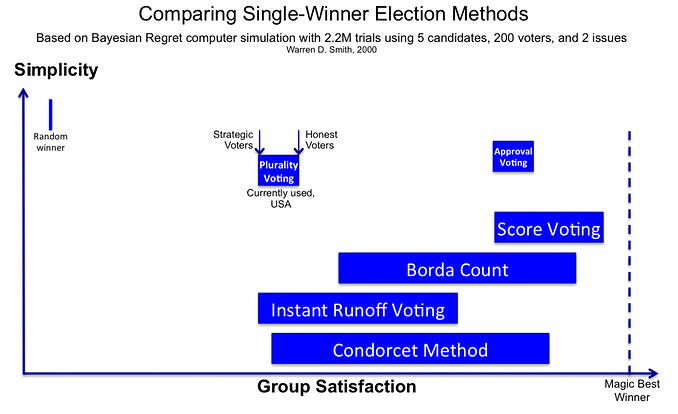
It’s clearly unfortunate as well that being a math dude he ranked the Simplicity axis on how simple it was for him to compute, and not how simple it is for normal humans to understand how to fill out their ballot. I’m looking at you, Score Voting.
Anyways - I haven’t been able to do the math on this yet, but if good old Warren D. Smith ran Power IRV through his Bayesian Regret-ometer* and updated his chart
* (what is Bayesian Regret? It’s like the computational inverse of happiness. Yeah, go and read up on that why don’t you? You’ll get it right away)
…I’d be willing to bet that we would find Power IRV beats out these other chump voting methods and we could finally build some consensus to actually make a change and dump this stupid FPTP voting BS once and for all:

Suck it Score Voting - and good luck rating every candidate from 0-100(!) anyways
Convinced yet?
Yeah you are. Let’s do this.
Tell your friends, tell your Congresspeople, push for Power IRV in your local elections and with voting reform organizations such as FairVote.
Or if you’re still not there yet, I’d love to hear from you. Drop me an email at the address at the bottom of the page with “Power IRV” somewhere in the subject and let’s talk.
Meanwhile, my fingers are crossed 🤞 that this idea gets us one step closer again towards our more Perfect Union.
Oh, the audacity..! 😉
Be well, my friends. Happy voting!
Still want more? Want to fully walk through some examples?
There’s a few more notes and questions answered in